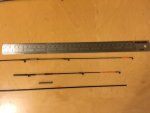I feel like something I know has come up on University Challenge

Your springtip is a different animal to the screw in quivertip. I first met them on the Weaver - a deep, canalised river in Cheshire - in the 80's. Blokes using these mysterious home-made indicators were getting the same number of bites as everyone else from the finnicky roach - but hitting twice as many.
There were a few versions that appeared in tackle shops, but most were a bit too clunky and involved springs with too heavy an action. They work best where deep water means the roach can be caught fairly close. The big advantage? The roach rattled a quiver tip and dropped the bait. The springtip folded without the resistance increasing, and the fish held on longer.
They're probably only of interest to someone who fishes for shy roach on places where they don't call them "silver fish" :wh

The top one's home-made and the spring is glued to a cut-down quivertip. The middle one is a modified Tri-cast one, with a short sleeve - a bit of pole tip offcut - to let me attach it to a rod top. Underneath are the makings of a third - a spring and a piece of pole tip offcut which will be cut to fit into the spring.
For what it's worth, I found that putting a ring between the spring and the tip reduced any unwanted casting wrap-overs or snagging.

